Energy Demand Forecast Models for Commercial Buildings in South Korea
Abstract
:1. Introduction
2. Methods
3. Analysis of Energy Consumption in Commercial Buildings
3.1. Energy Statistical Analysis
3.2. Trend of Energy Consumption in Commercial Buildings
4. Development of Demand Forecasting Model
4.1. Methodology Establishment
4.1.1. Analysis of the Econometrics Model
4.1.2. Analysis of End-Use Model
4.2. Building Basic Data
4.2.1. Variable Base Data
4.2.2. Floor Area Data
4.3. Demand Forecast Model by Energy
4.3.1. Petroleum Model
4.3.2. City Gas Model
4.3.3. Electricity Model
4.3.4. Heat Model
4.3.5. Renewables Model
4.3.6. Energy Demand Forecast Result
5. Discussion
6. Conclusions
- We developed an appropriate energy demand forecast method by analyzing the characteristics of the econometrics model and the end-use account model. The demand forecast model for each energy source was constructed using a hybrid method combining both top-down and bottom-up methods.
- The floor area forecast model until 2030 for commercial buildings was developed using GDP per person and energy consumption, which have high correlations with floor area. According to the forecast results, the total floor area in 2030 was estimated to be 1231 million m2 and the annual increase rate from 2019 to 2030 was 0.91%.
- For the petroleum energy demand forecast model, the energy consumption trend was derived as the most appropriate variable for forecasting demand. The R2 of this model was 89% and the p-value was 0, indicating statistical significance. According to the forecast results, the petroleum energy consumption was forecasted to decrease to 1482 thousand toe in 2030 at an annual average rate of −1.7% from 2019 to 2030.
- The most appropriate variable for city gas energy demand forecast was the building floor area. The R2 of the model was 96% and the p-value was 0. According to the forecast results, the gas energy consumption was estimated to increase to 4157 thousand toe in 2030 at an annual average rate of 0.4% from 2019 to 2030.
- The electricity energy demand was forecasted using the Electricity Demand and Supply Basic Plan. The proportion of commercial buildings in the national total electricity consumption published in this plan was 25.5%. It was thus used for the electricity energy demand forecast of commercial buildings. Accordingly, the consumption was forecasted to increase to 14,627 thousand toe in 2030 at an annual average rate of 2.1% from 2019 to 2030.
- The most appropriate variable for heat energy demand forecast derived from the analysis of variables was floor area. The p-value of this model was 0.006, indicating statistical significance. According to the forecast results, the heat energy consumption was forecasted to decrease to 182 thousand toe in 2030 at an annual rate of −0.2% from 2019 to 2030.
- The renewable energy demand was forecasted to account for 1.1% of the energy demand forecast results of other energies. This consumption was forecasted to increase to 225 thousand toe in 2030 at an annual average rate of 1.3% from 2019 to 2030.
Author Contributions
Funding
Conflicts of Interest
References
- Park, S.W. Post-2020 Climate Regime and Paris Agreement. Environ. Law Policy 2016, 16, 285–322. [Google Scholar] [CrossRef]
- Korea Energy Economics Institute. Energy Balance; 2017 Yearbook of Energy Statistics; KEEI: Ulsan, Korea, 2018; Volume 35, pp. 296–349. [Google Scholar]
- Lee, C.Y.; Huh, S.Y. Forecasting new and renewable energy supply through a bottom-up approach: The case of South Korea. Renew. Sustain. Energy Rev. 2017, 69, 207–217. [Google Scholar] [CrossRef]
- Shin, J.; Lee, C.Y.; Kim, H. Technology and demand forecasting for carbon capture and storage technology in South Korea. Energy Policy 2016, 98, 1–11. [Google Scholar] [CrossRef]
- Ministry of Trade, Industry. Energy Basic Plan; Ministry of Trade, Industry: Sejong City, Korea, 2014.
- Ministry of Trade, Industry. Electricity Demand and Supply Basic Plan; Ministry of Trade, Industry: Sejong City, Korea, 2017.
- Ministry of Trade, Industry. Long-Term Natural Gas Demand and Supply Plan; Ministry of Trade, Industry: Sejong City, Korea, 2018.
- Jeon, H.C.; Chung, Y.M. Survey on Energy Demand Forecasting Models for the Development of Energy-Environment Outlook Model. Korea Environ. Inst. 2018, 2018, 1–59. [Google Scholar]
- Papadopoulos, S.; Bonczak, B.; Kontokosta, C.E. Pattern recognition in building energy performance over time using energy benchmarking data. Appl. Energy 2018, 221, 576–586. [Google Scholar] [CrossRef] [Green Version]
- Livingston, O.V.; Pulsipher, T.C.; Anderson, D.M.; Vlachokostas, A.; Wang, N. An analysis of utility meter data aggregation and tenant privacy to support energy use disclosure in commercial buildings. Energy 2018, 159, 302–309. [Google Scholar] [CrossRef]
- IEA. Online Annex: Energy-Efficient Buildings in the Urban Environment (Chapter 4); IEA: Paris, France, 2016. [Google Scholar]
- Ortiz, L.E.; Gonzalez, J.E.; Gutierres, E.; Arend, M. Forecasting Building Energy Demands with a Coupled Weather-Building Energy Model in a Dense Urban Environment. J. Sol. Energy Eng. 2016, 139, 011002-1–011002-8. [Google Scholar] [CrossRef]
- Jeong, Y.S.; Cho, C.H. A Forecast of Energy Demand in Building Sector using Energy System Model. J. Korean Inst. Archit. Sustain. Environ. Build. Syst. 2016, 10, 368–374. [Google Scholar]
- Wang, N.; Vlachokostas, A.; Borkum, M.; Bergmann, H.; Zaleski, S. Unique Building Identifier: A natural key for building data matching and its energy applications. Energy Build. 2019, 184, 230–241. [Google Scholar] [CrossRef]
- Bueno, B.; Norford, L.; Pigeon, G. Combining a Detailed Building Energy Model with a Physically-Based Urban Canopy Model. Bound. Layer Meteorol. 2011, 140, 471–489. [Google Scholar] [CrossRef]
- Roop, J.M.; Dahowski, R.T. Comparison of Bottom-up and Top-down Forecasts: Vision Industry Energy Forecasts with Items and Nems. Natl. Ind. Energy Technol. Conf. 2010, 22, 84–88. [Google Scholar]
- Ministry of Trade, Industry Energy. Commercial and Public Services; 2017 Energy Consumption Survey; Ministry of Trade, Industry Energy: Sejong City, Korea, 2018; pp. 540–600.
- Gutiérrez, E.; González, J.E.; Bornstein, R. A New Modeling Approach to Forecast Building Energy Demands During Extreme Heat Events in Complex Cities. J. Sol. Energy Eng. 2011, 135, 1879–1884. [Google Scholar] [CrossRef]
- Li, K.; Su, H. Forecasting building energy consumption with hybrid genetic algorithm-hierarchical adaptive network-based fuzzy inference system. Energy Build. 2010, 42, 2070–2076. [Google Scholar] [CrossRef]
- Li, X.; Wen, J. Building energy consumption on-line forecasting using physics-based system identification. Energy Build. 2014, 82, 1–12. [Google Scholar] [CrossRef]
- Zhang, F.; Deb, C.; Lee, S.E.; Yang, J. Time series forecasting for building energy consumption using weighted Support Vector Regression with differential evolution optimization technique. Energy Build. 2016, 126, 94–103. [Google Scholar] [CrossRef]
- Rouchier, S.; Rabouille, M.; Oberle, P. Calibration of simplified building energy models for parameter estimation and forecasting: Stochastic versus deterministic modelling. Build. Environ. 2018, 134, 181–190. [Google Scholar] [CrossRef]
- Eom, J.; Clark, L.; Kim, S.H. China’s Building Energy Demand: Long-Term Implications from a Detailed Assessment. Energy 2012, 46, 405–419. [Google Scholar] [CrossRef]
- Kyle, P.; Clarke, L.; Rong, F. Climate Policy and the Long-Term Evolution of the U.S. Buildings Sector. Energy J. 2010, 31, 145–172. [Google Scholar] [CrossRef]
- IEA. Transition to Sustainable Buildings; Strategies and Opportunities to 2050; IEA: Paris, France, 2013. [Google Scholar]
- Depecker, P.; Menezo, C.; Virgone, J.; Lepers, S. Design of buildings shape and energetic consumption. Build. Environ. 2001, 36, 627–635. [Google Scholar] [CrossRef]
- IEA. Available online: https://iea.org/books (accessed on 9 June 2017).
- World Bank. Available online: https://data.worldbank.org/country (accessed on 10 March 2018).
- Michale, A.M.; Virginie, E.L.; Stephane, R.C. Global Potential of Energy Efficiency Standards and Labeling Programs; LBNL: Berkeley, CA, USA, 2008; pp. 7–99.
- Cao, Z.; Yuan, P.; Ma, Y.B. Energy Demand Forecasting Based on Economy-related Factors in China. Energy Sources Part B Econ. Plan. Policy 2014, 9, 214–219. [Google Scholar] [CrossRef]
- Ulhaner, R.; Cason, T.; Smith, B. A Method of Forecasting End-Use Energy Usage Patterns Using Customer Attributes. Atomic Energy Comm. USA 1991, 100396, 1–21. [Google Scholar]
- Modis, T. Forecasting energy needs with logistics. Technol. Forecast. Soc. Chang. 2019, 139, 135–143. [Google Scholar] [CrossRef]
- Fujime, K. An Analysis of and Forecast for Economic Development and Energy Demand in Asia/Pacific Countries. Congr. World Energy Counc. 1995, 11, 231–250. [Google Scholar]
- Vinutha, H.D.; Gouda, K.C.; Chandan, K.N. Electric Load Forecasting using a Neural Network Approach. IJCTT 2014, 11, 244–249. [Google Scholar]
- Ardakani, F.J.; Ardehali, M.M. Long-term electrical energy consumption forecasting for developing and developed economies based on different optimized models and historical data types. Energy 2014, 65, 452–461. [Google Scholar] [CrossRef]
- Ministry of Trade, Industry Energy. The 8th Korea Power Supply and Demand Plan; Ministry of Trade, Industry Energy: Sejong City, Korea, 2018.
- Kaboli, S.H.; Selvaraj, J.; Rahim, N.A. Long-term electric energy consumption forecasting via artificial cooperative search algorithm. Energy 2016, 115, 857–871. [Google Scholar] [CrossRef]
- In, C.H. Seoul Energy Demand Forecast 2015–2035: An Application of the MAED. J. Environ. Policy Adm. 2015, 23, 47–76. [Google Scholar]
- Lee, S.C.; Shih, L.H. Forecasting of electricity costs based on an enhanced gray-based learning model: A case study of renewable energy in Taiwan. Technol. Forecast. Soc. Chang. 2011, 78, 1242–1253. [Google Scholar] [CrossRef]
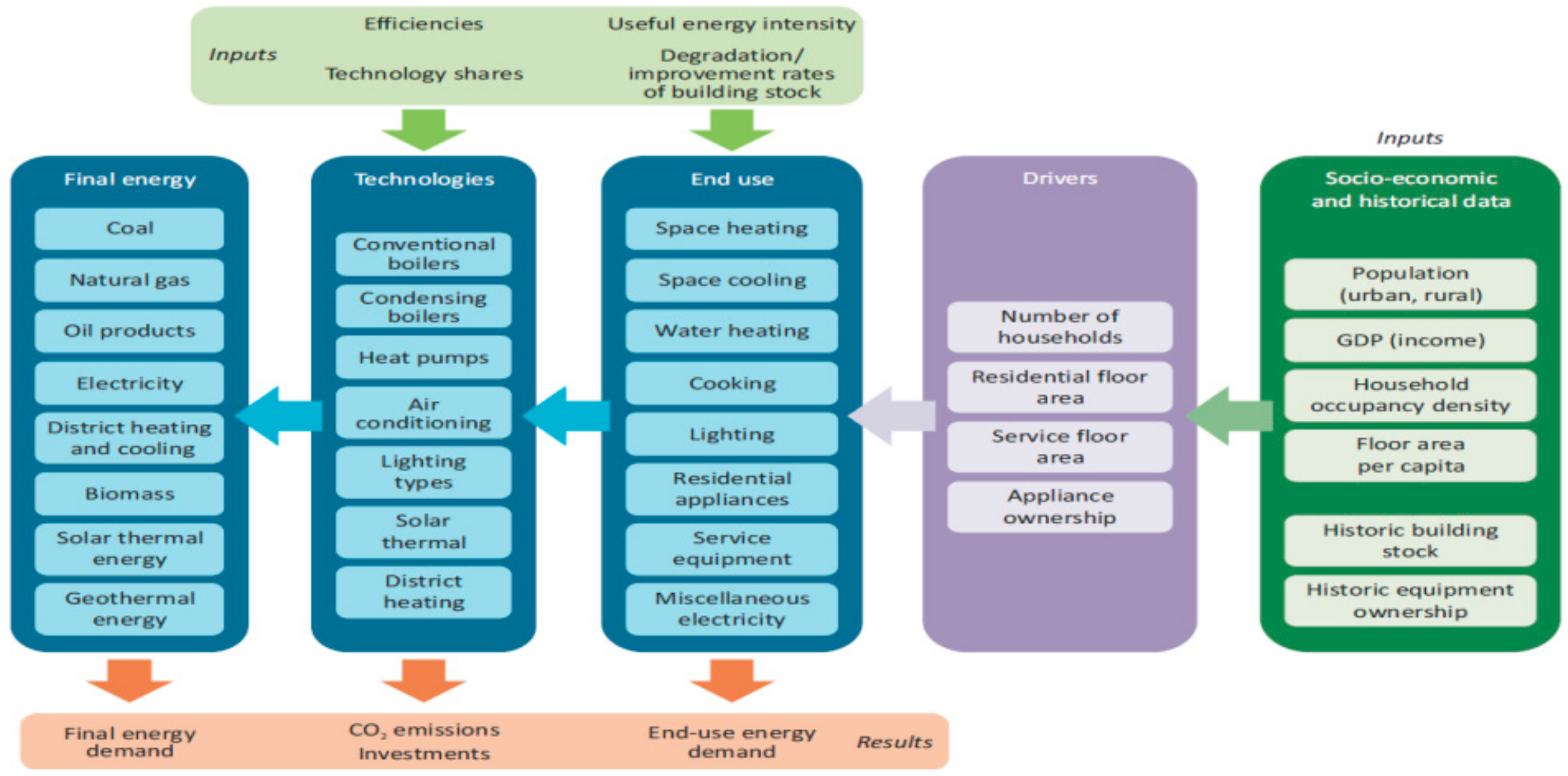
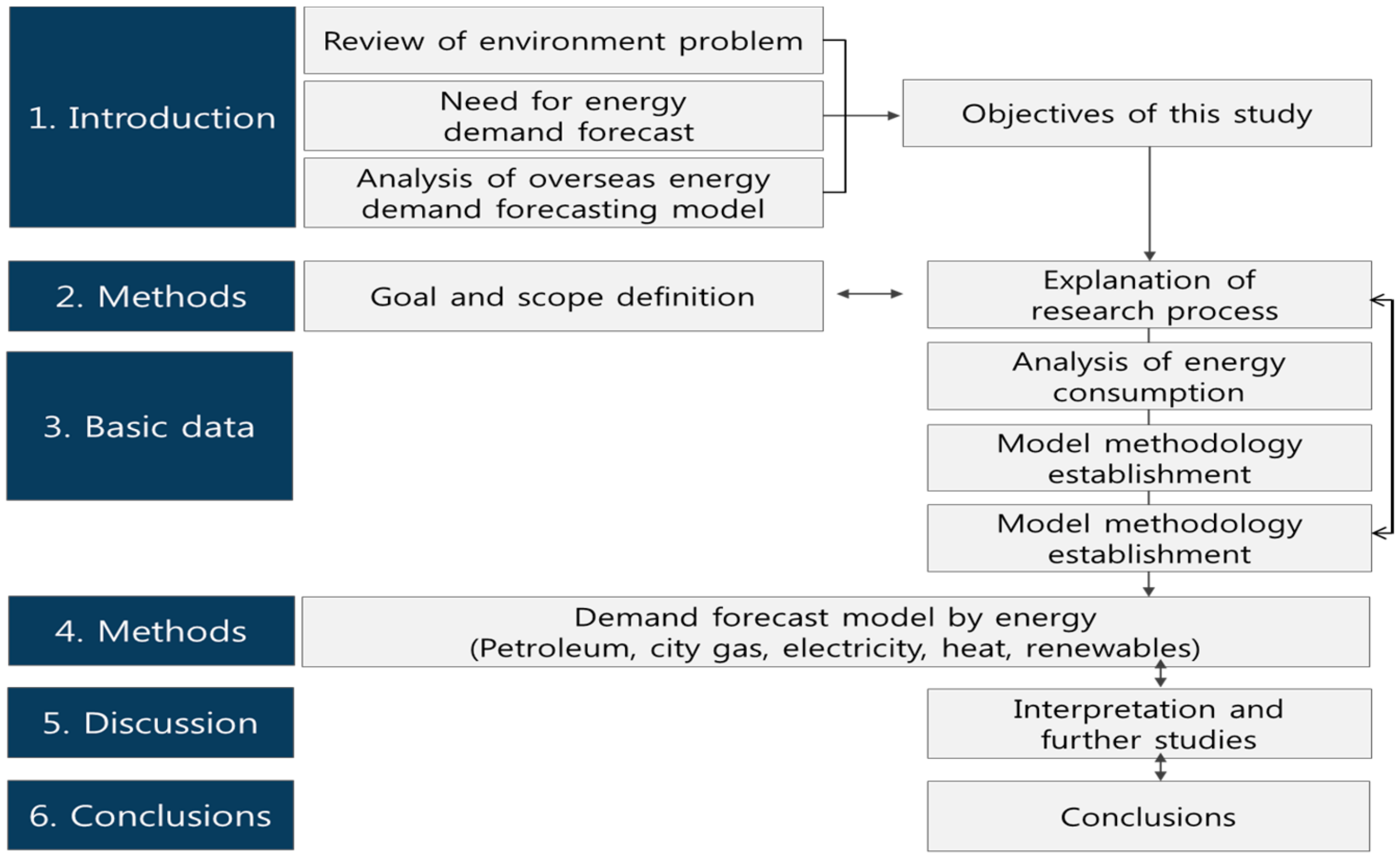
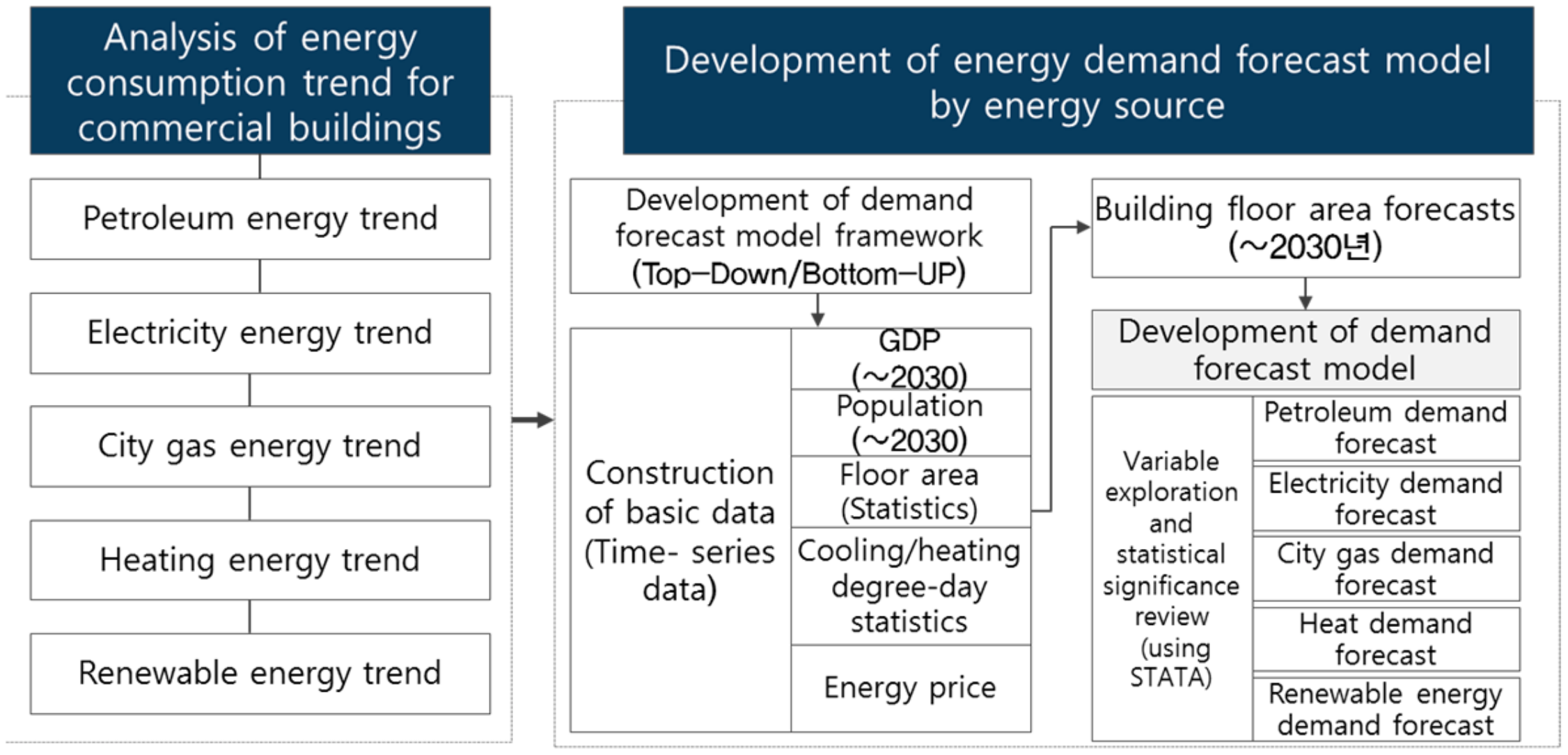
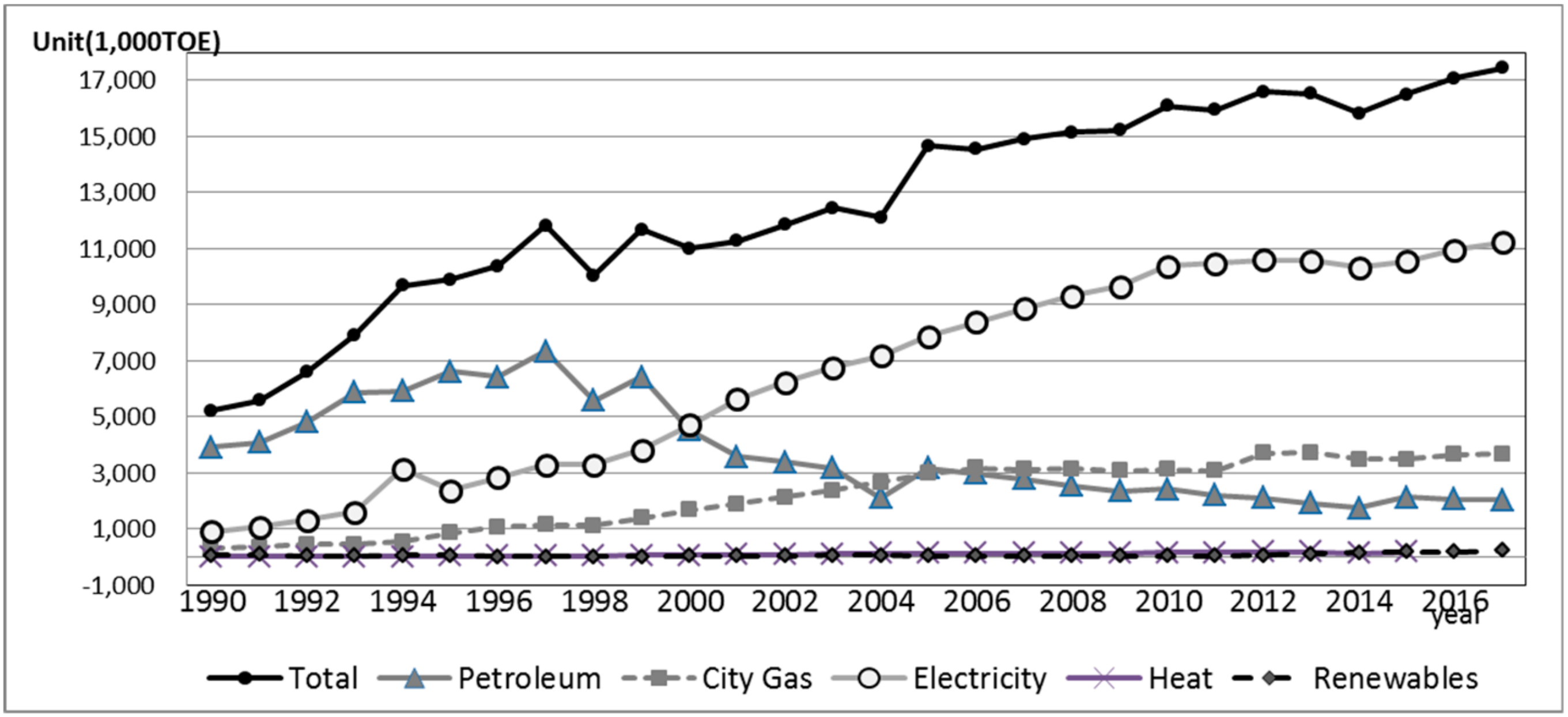
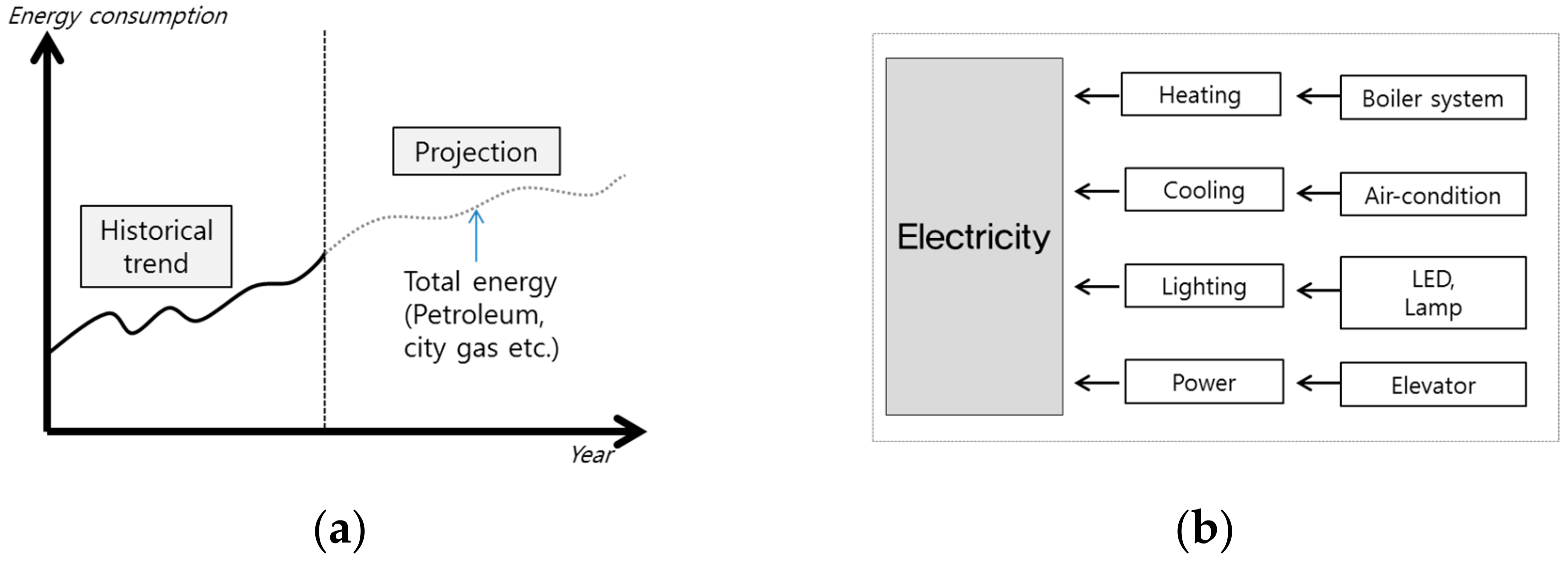

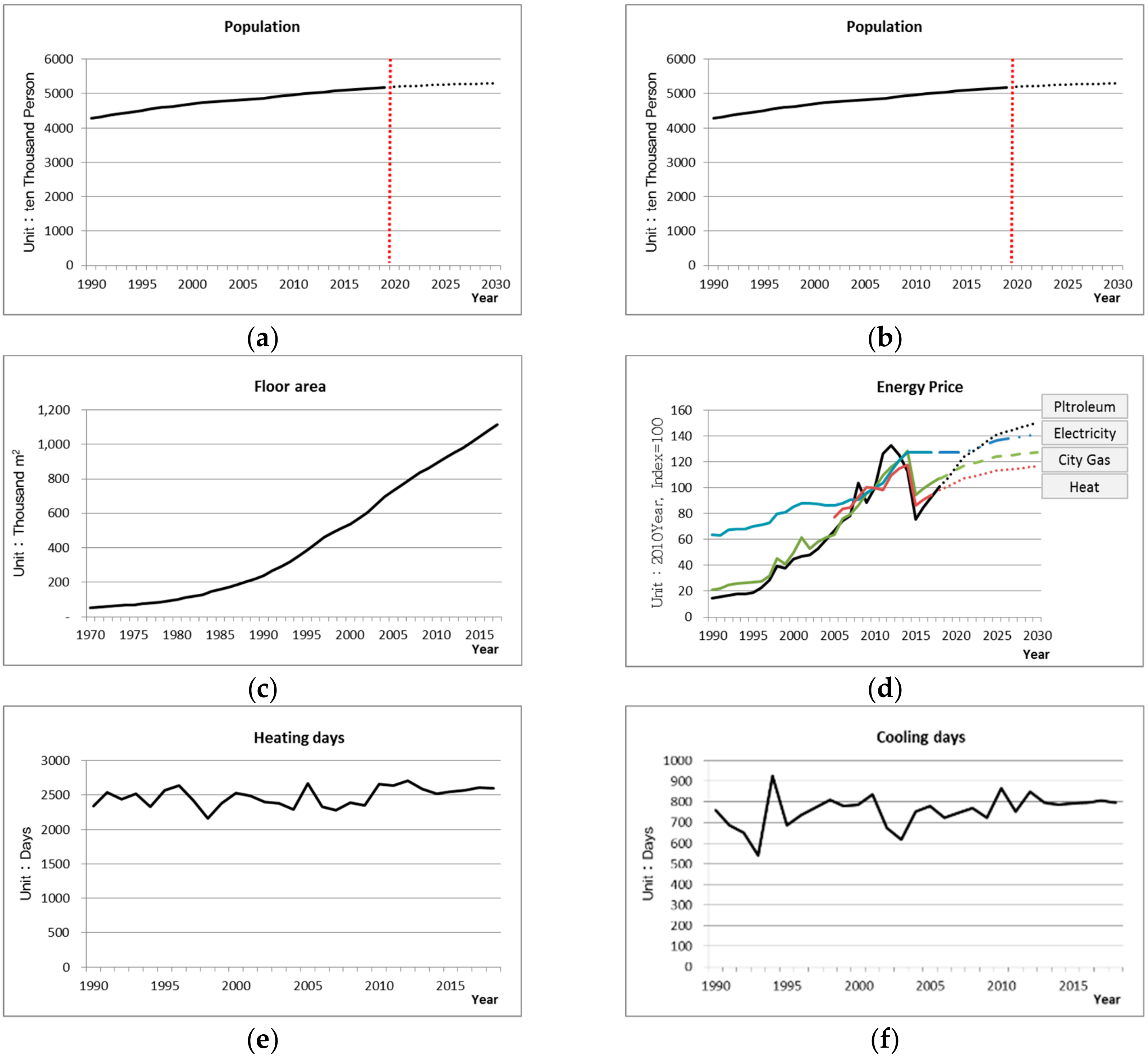
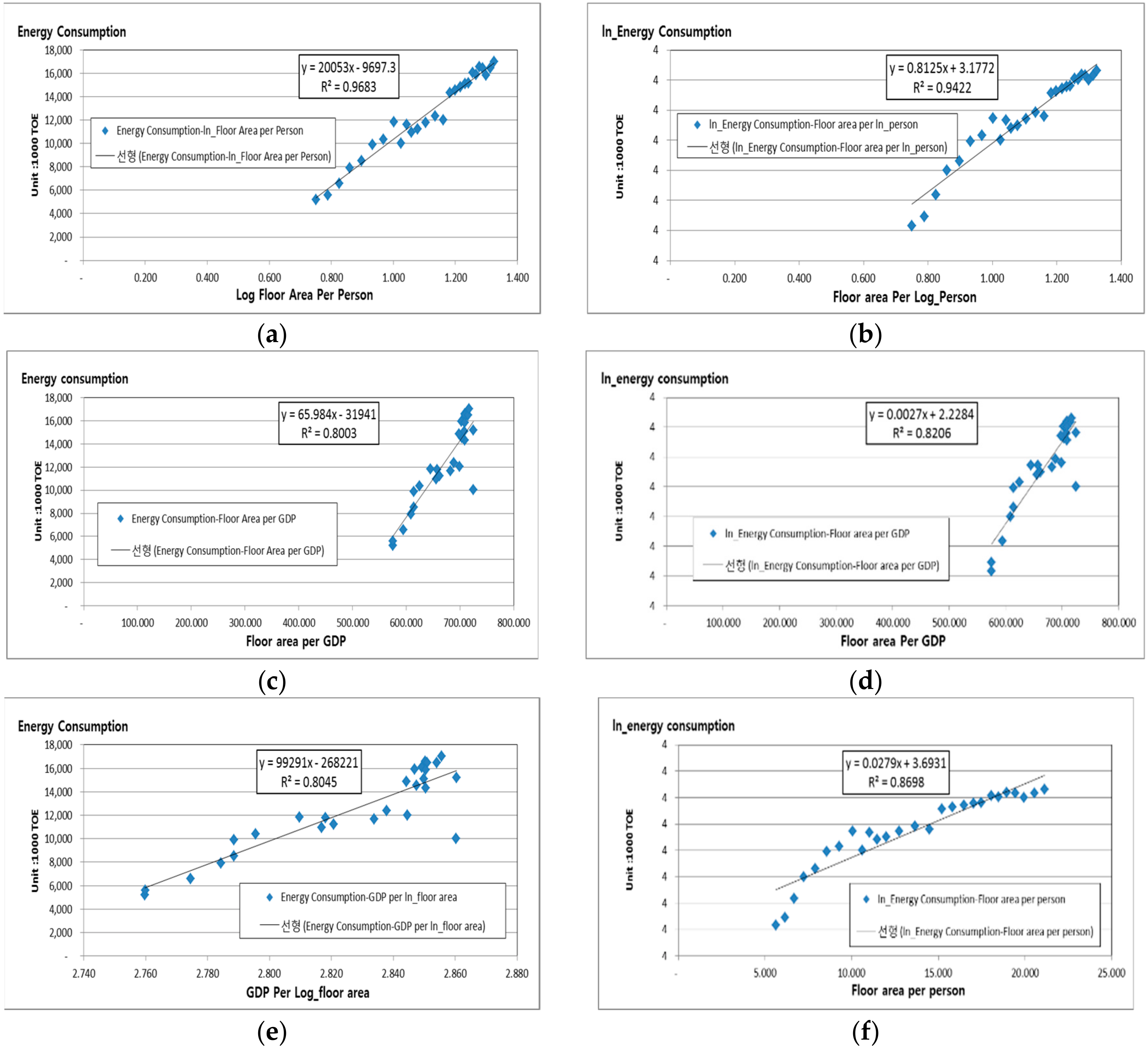
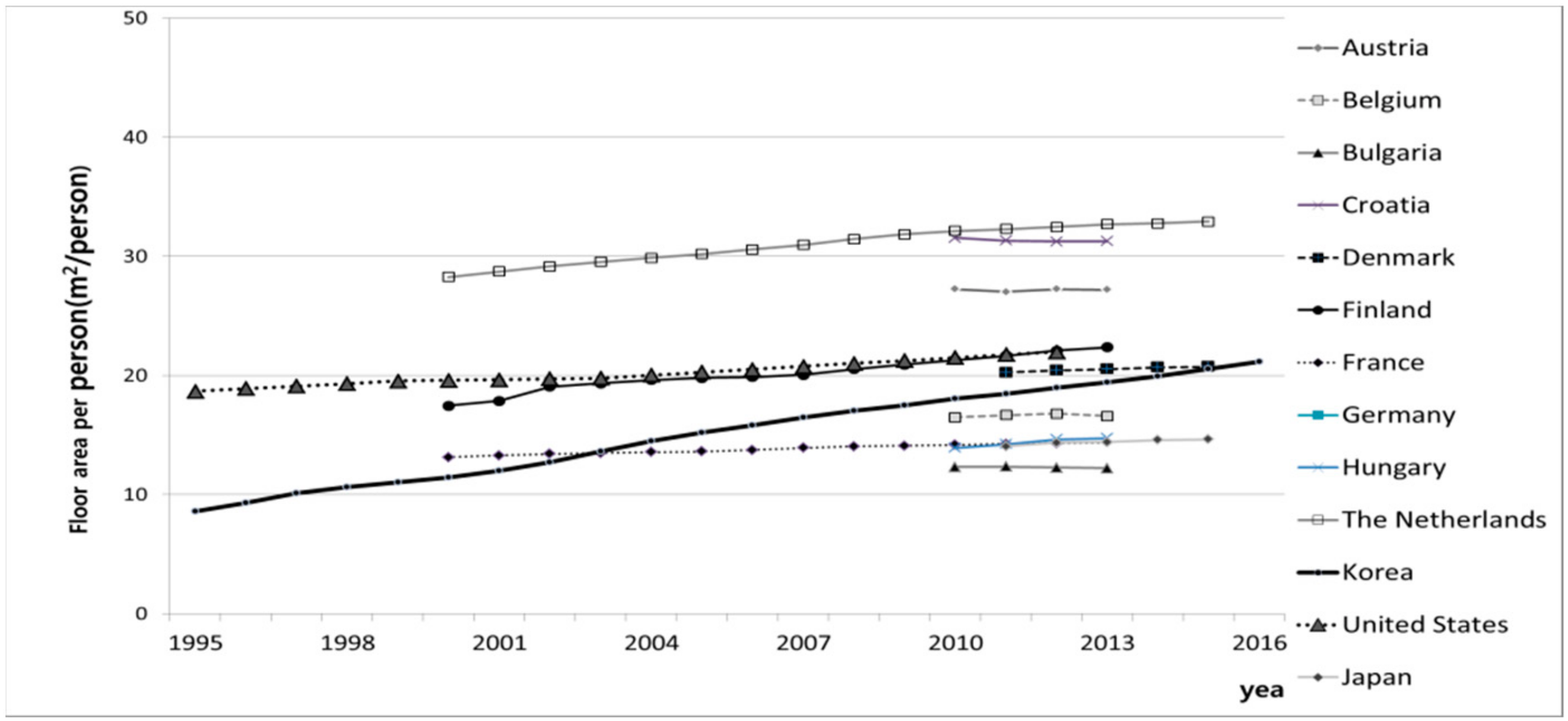








| Division | Year Book of Energy Statistics | Energy Consumption Survey |
|---|---|---|
| Time of publication | Every year | Every three years |
| Survey method | Monthly production and sales results Based on inputs | Combination of self-enumeration method and interviewing method for samples |
| Purpose of use | Total energy consumptions (Top-down) | Proportions by building use and energy source (Bottom-up) |
| Advantages | Total energy consumption of commercial buildings High reliability | Statistics by energy source can be used |
| Disadvantages | No statistics by energy source | Low reliability of total energy consumption data |
| Category | Contents |
|---|---|
| Population | Yearly statistical and forecast data for 1990–2030 Annual average growth rate 0.53% (1990–2030) |
| GDP | Yearly statistical and forecast data for 1990–2030 Annual average growth rate 3.34% (1990–2030) |
| Floor Area | Statistical data for 1970–2017 Annual average growth rate 6.76% (1970–2017) |
| Heating/Cooling day | Statistical data for 1970–2017 Not forecast |
| Energy Price | Yearly statistical and forecast data for 1990–2030 Annual average growth rate 4.54% (1990–2030) |
| Year | 2015 | 2018 | 2020 | 2025 | 2030 | Annual Increase (2019–2030) |
|---|---|---|---|---|---|---|
| Floor Area (million m2) | 1048 | 1088 | 1092 | 1168 | 1231 | 0.91% |
| Year | 2015 | 2018 | 2020 | 2025 | 2030 | Annual Increase (2019–2030) |
|---|---|---|---|---|---|---|
| Energy (1000 toe) | 2127 | 1829 | 1754 | 1601 | 1482 | −1.7% |
| Year | 2015 | 2018 | 2020 | 2025 | 2030 | Annual Increase (2019–2030) |
|---|---|---|---|---|---|---|
| Energy (1000 toe) | 3469 | 3971 | 4013 | 4110 | 4157 | 0.4% |
| Year | 2015 | 2018 | 2020 | 2025 | 2030 | Annual Increase (2019–2030) |
|---|---|---|---|---|---|---|
| Energy (1000 toe) | 10,533 | 11,480 | 12,112 | 13,504 | 14,627 | 2.1% |
| Year | 2015 | 2018 | 2020 | 2025 | 2030 | Annual Increase (2019–2030) |
|---|---|---|---|---|---|---|
| Energy (1000 toe) | 163 | 177 | 180 | 182 | 182 | 0.2% |
| Year | 2015 | 2018 | 2020 | 2025 | 2030 | Annual Increase (2019–2030) |
|---|---|---|---|---|---|---|
| Energy (1000 toe) | 174 | 185 | 199 | 213 | 225 | 1.3% |
| Year | Energy (1000 toe) | ||||
|---|---|---|---|---|---|
| Petroleum | City Gas | Electricity | Heat | Renewables | |
| 2019 | 1790 | 3992 | 11,798 | 179 | 195 |
| 2020 | 1754 | 4013 | 12,112 | 180 | 199 |
| 2021 | 1720 | 4033 | 12,428 | 180 | 202 |
| 2022 | 1688 | 4053 | 12,711 | 181 | 205 |
| 2023 | 1657 | 4072 | 12,985 | 181 | 208 |
| 2024 | 1628 | 4091 | 13,248 | 181 | 211 |
| 2025 | 1601 | 4110 | 13,504 | 182 | 213 |
| 2026 | 1575 | 4120 | 13,752 | 182 | 216 |
| 2027 | 1550 | 4130 | 13,989 | 182 | 218 |
| 2028 | 1527 | 4139 | 14,208 | 182 | 221 |
| 2029 | 1504 | 4149 | 14,423 | 182 | 223 |
| 2030 | 1482 | 4157 | 14,627 | 182 | 225 |
| Annual Increase | −1.7% | 0.4% | 2.1% | 0.2% | 1.3% |
© 2019 by the authors. Licensee MDPI, Basel, Switzerland. This article is an open access article distributed under the terms and conditions of the Creative Commons Attribution (CC BY) license (http://creativecommons.org/licenses/by/4.0/).
Share and Cite
Ha, S.; Tae, S.; Kim, R. Energy Demand Forecast Models for Commercial Buildings in South Korea. Energies 2019, 12, 2313. https://doi.org/10.3390/en12122313
Ha S, Tae S, Kim R. Energy Demand Forecast Models for Commercial Buildings in South Korea. Energies. 2019; 12(12):2313. https://doi.org/10.3390/en12122313
Chicago/Turabian StyleHa, Sungkyun, Sungho Tae, and Rakhyun Kim. 2019. "Energy Demand Forecast Models for Commercial Buildings in South Korea" Energies 12, no. 12: 2313. https://doi.org/10.3390/en12122313





